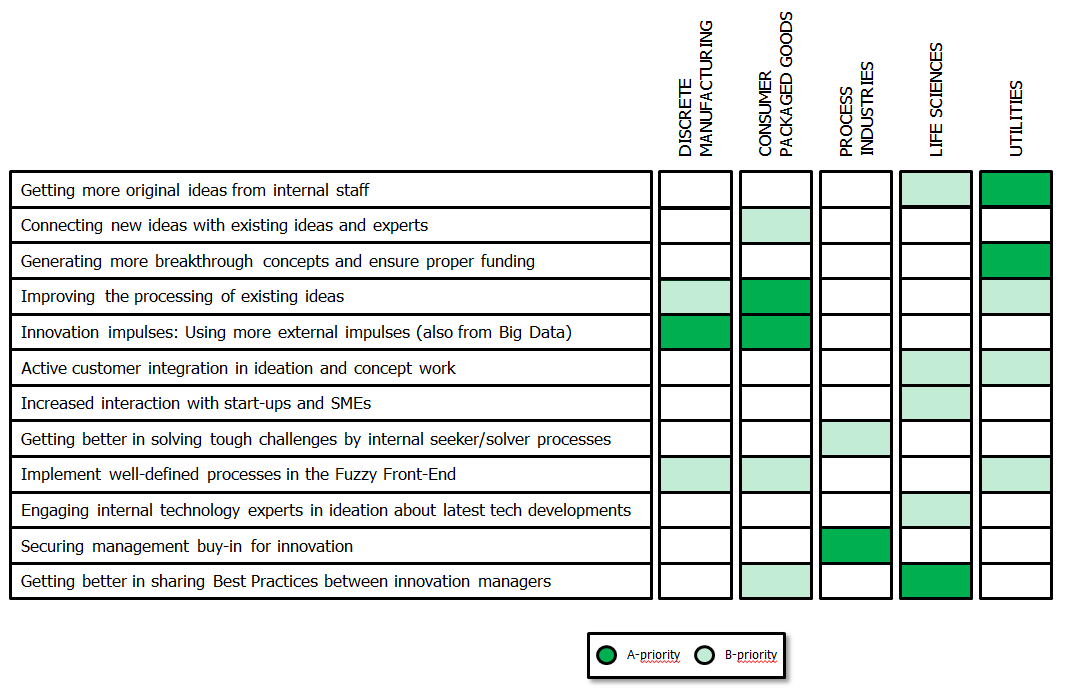In our last posts we have built a case that large organizations should invest energy in actively designing their early phase of the innovation process – the so-called “Fuzzy Front-End” (FFE) in a way that it delivers meaningful and promising innovation ideas and concepts. It is emerging practice that there are some key design parameters (see our last post for more details) but it requires concentrated work.
Moreover, as we will lay out in future posts, when innovation ideas and concepts come out from an “optimally designed” FFE this does not guarantee that the organization takes up the innovation and runs with it. What we observe is that firms spend significantly more energy and resources on coming up with innovation ideas and concepts than they do in making the organization absorbing these.
One could mockingly say that firms these days approach innovation management in the FFE the same way as they did with innovation (as a whole) in the past: “Build it and they will come”. More on this and how to change it in future posts.
In this post, we want to continue our train of thought about excellence in the FFE – which is the source of superior innovation results. More specifically: What are priorities in designing / optimizing the FFE in different industry sectors? What are companies saying about about their current and future needs?
The stories we (and probably you as well) hear often
- “We need new ideas” – New ideas or combinations of existing ideas are the starting point of the innovation process.
- “We need to become better in processing ideas” – It is not healthy to take in more food if one’s digestive system is blocked.
- “We need more inspiration” – Nowadays it is Good Practice to have a number of channels for new ideas into the organization.
- “We need to use better the experts we have” – More and more firms are using internal “seeker/solver” processes to crowdsource solutions to tough innovation challenges.
- “We need to accelerate the Fuzzy Front-End” – Typically, a significant portion of the time-to-profit for innovation ideas is spent in the FFE.
- “We need to better understand the relevance of new technologies” – Some firms are testing whether software tools, processes and physical events could improve assessment.
- “We need improve in our culture” – Some firms are seeing organizational behavior as the main challenge.
Current priorities in optimizing the FFE
Different industry sectors have different challenges; that’s no surprise. Competitive environments combine with competitive dynamics, industry innovation clock-speed, differing consumer trends and demands.
Our study drew companies across 5 sectors. And here is what we have found about where companies are today:
- Discrete Manufacturing (e.g. machinery or consumer electronics) firms are mainly striving to use more and better innovation impulses. Their second priority is to improve the processing of ideas and to improve structuring the FFE via well-defined processes.
- Consumer Packaged Goods firms are primarily working on using more and better innovation impulses and on improving the processing of ideas to build on these insights. Additionally they are also trying to get better in structuring the FFE and in sharing Best Practices across the organization.
- Firms from Process Industries (e.g. Chemicals) are focusing on securing management buy-in for innovation. Secondly, they are trying to leverage their existing expertise base by running internal seeker/solver processes in order to solve tough innovation challenges.
- Life Sciences firms are confident that they have a world-class base of experts. For them, the key priority is to make their internal experts to share best Practices. The second priority is to extend their innovation ecosystem and to search for new approaches in order to create more ideas from their staff.
- Due to market disruptions for many Utilities firms, their main focus is on getting more ideas from internal staff and produce a large number of potential breakthrough concepts that may be the basis for future business models. They are also working on improving the processing of ideas with structured processes and on improving innovation effectiveness by actively integrating customers.
Future priorities
We also asked our interview partners about where they saw things going in the future for developing the FFE of their firms. This does not mean that current priorities would be of no relevance in the future. Rather this means that in the future additional topics will become focal points for optimizing their FFE.
As expected, the answers we received vary from industry to industry. The results are presented with actual statements made by respondents:
- Discrete Manufacturing: Improving innovation behavior of management and of staff (“Biggest challenge: Act beyond the words” and “We need to become more professional in using what we have.”)
- Consumer Packaged Goods: Improving clarity and the deployment of the innovation strategy and improving innovation behavior (“We need to get a clearer image of how to do disruptive innovation” and “Establish cross-business unit co-operation for the idea stage.”)
- Process Industries: Improving innovation behavior of management and improving processes and procedures (“Separate systems for bread & butter vs. disruptive innovation” and “Establish fail fast / fail forward culture.”)
- Life Sciences: Improving innovation behavior of both management and staff plus establishing more risk-taking in the culture (“Aligning and liberating capabilities” and “We need to become better at appropriate risk-taking.”)
- Utilities: Becoming more Open in innovation and improving the innovation behavior of management and staff (“Breaking silos with outside world” and “Establish new values for staff and Executive behavior.”)
In the next article we focus on the opportunities that software and digital innovation approaches can bring to solving issues and problems for the companies in our study.
REFLECTIVE QUESTION: What are your current priorities to improve the design of the FFE in your sector and company? Where are things heading and how will you get there?
Please contact us if you would like to give new innovation momentum and create a highly effective approach to your innovation activities.


